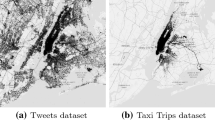Abstract
We consider preprocessing a set S of n points in convex position in the plane into a data structure supporting queries of the following form: given a point q and a directed line \(\ell \) in the plane, report the point of S that is farthest from (or, alternatively, nearest to) the point q among all points to the left of line \(\ell \). We present two data structures for this problem. The first data structure uses \(O(n^{1+\varepsilon })\) space and preprocessing time, and answers queries in \(O(2^{1/\varepsilon }\log n)\) time, for any \(0< \varepsilon < 1\). The second data structure uses \(O(n \log ^3 n)\) space and polynomial preprocessing time, and answers queries in \(O(\log n)\) time. These are the first solutions to the problem with \(O(\log n)\) query time and \(o(n^2)\) space. The second data structure uses a new representation of nearest- and farthest-point Voronoi diagrams of points in convex position. This representation supports the insertion of new points in clockwise order using only \(O(\log n)\) amortized pointer changes, in addition to \(O(\log n)\)-time point-location queries, even though every such update may make \(\Theta (n)\) combinatorial changes to the Voronoi diagram. This data structure is the first demonstration that deterministically and incrementally constructed Voronoi diagrams can be maintained in o(n) amortized pointer changes per operation while keeping \(O(\log n)\)-time point-location queries.






Similar content being viewed by others
Notes
Daescu et al. [8] pose a closely related problem, whether \(O(\log n)\) query time is possible with \(O(n \log n)\) space and preprocessing time.
We use the term “Transform” to denote a type of theorem that represents a data structure transformation.
This convention is arbitrary, but it allows first setting the marks of \((w,w')\) via Left-Mark and Right-Mark to effectively set the marks of \((v',w')\).
Given the number of arguments, it is tempting to refer to the oracle as \(O_A(B,D,G,I,L,S)\), but we will resist that temptation.
Note that this notion of flarb is different from that of [12].
Unlike most terminology in this paper, these terms are used for no particular reason. Cf. footnote 5.
References
Allen, S., Barba, L., Iacono, J., Langerman, S.: Incremental Voronoi diagrams. Discrete Comput. Geom. (to appear). Special issue of selected papers from the 2016 Symposium on Computational Geometry (SoCG’16). http://arxiv.org/abs/1603.08485
Aggarwal, A., Guibas, L.J., Saxe, J.B., Shor, P.W.: A linear-time algorithm for computing the Voronoi diagram of a convex polygon. Discrete Comput. Geom. 4(6), 591–604 (1989)
Chan, T.M.: A dynamic data structure for 3-D convex hulls and 2-D nearest neighbor queries. J. ACM 57(3), Article No. 16 (2010). https://doi.org/10.1145/1706591.1706596
Cromley, R.G.: Digital Cartography. Prentice Hall, Upper Saddle River (1991)
Chiang, Y.-J., Tamassia, R.: Dynamic algorithms in computational geometry. Proc. IEEE 80(9), 1412–1434 (1992)
de Berg, M., van Kreveld, M., Overmars, M., Schwarzkopf, O.: Computational Geometry: Algorithms and Applications, 2nd edn. Springer, Berlin (1999)
Dent, B.D.: Cartography: Thematic Map Design, 5th edn. William C Brown Pub, Dubuque (1998)
Daescu, O., Mi, N., Shin, C.-S., Wolff, A.: Farthest-point queries with geometric and combinatorial constraints. Comput. Geom. Theory Appl. 33(3), 174–185 (2006)
Driscoll, J.R., Sarnak, N., Sleator, D.D., Tarjan, R.E.: Making data structures persistent. J. Comput. Syst. Sci. 38(1), 86–124 (1989)
Edelsbrunner, H., Guibas, L., Stolfi, J.: Optimal point location in a monotone subdivision. SIAM J. Comput. 15(2), 317–340 (1986)
Eppstein, D.: The farthest point Delaunay triangulation minimizes angles. Comput. Geom. Theory Appl. 1(3), 143–148 (1992)
Flarb mania!!. http://wave-fan-4ever.tripod.com/flarbmania/ (2004)
McMaster, R.B., Shea, K.S.: Generalization in Digital Cartography. Association of American Cartographers, Washington (1992)
O’Rourke, J.: Computational Geometry in C, 2nd edn. Cambridge University Press, Cambridge (1998)
Overmars, M.H.: The Design of Dynamic Data Structures, Volume 156 of Lecture Notes in Computer Science. Springer, Berlin (1983)
Pettie, Seth: Applications of forbidden 0-1 matrices to search tree and path compression-based data structures. In: Proceedings of the Twenty-First Annual ACM-SIAM Symposium on Discrete Algorithms, pp. 1457–1467 (2010)
Preparata, F.P., Shamos, M.I.: Computational Geometry: An Introduction. Springer, Berlin (1993)
Sleator, D.D., Tarjan, R.E.: A data structure for dynamic trees. J. Comput. Syst. Sci. 26(3), 362–391 (1983)
Sleator, D.D., Tarjan, R.E.: Self-adjusting binary search trees. J. ACM 32(3), 652–686 (1985)
Acknowledgements
This work was initiated at the Schloss Dagstuhl Seminar 04091 on Data Structures, organized by Susanne Albers, Robert Sedgewick, and Dorothea Wagner, and held February 22–27, 2004 in Germany. This work continued at the Korean Workshop on Computational Geometry and Geometric Networks, organized by Hee-Kap Ahn, Christian Knauer, Chan-Su Shin, Alexander Wolff, and René van Oostrum, and held July 25–30, 2004 at Schloss Dagstuhl in Germany; and at the 2nd Bertinoro Workshop on Algorithms and Data Structures, organized by Andrew Goldberg and Giuseppe Italiano, and held May 29–June 4, 2005 in Italy. We thank the organizers and institutions hosting these workshops for providing a productive research atmosphere. We also thank Alexander Wolff for introducing the problem to us.
Author information
Authors and Affiliations
Corresponding author
Additional information
A preliminary version of this paper appeared in Proceedings of the 7th Latin American Symposium on Theoretical Informatics, Valdivia, Chile, March 2006.
B. Aronov: Research supported in part by NSF Grant ITR-0081964 and by a Grant from US-Israel Binational Science Foundation.
P. Bose and M. Smid: Research supported in part by NSERC.
E. D. Demaine: Research supported in part by NSF Grants CCF-0430849 and OISE-0334653.
J. Iacono: Research supported in part by NSF Grants CCF-0430849, OISE-0334653, CCF-1319648, CCF-1018370, and CNS-1229185, and a Grant from US-Israel Binational Science Foundation.
Rights and permissions
About this article
Cite this article
Aronov, B., Bose, P., Demaine, E.D. et al. Data Structures for Halfplane Proximity Queries and Incremental Voronoi Diagrams. Algorithmica 80, 3316–3334 (2018). https://doi.org/10.1007/s00453-017-0389-y
Received:
Accepted:
Published:
Issue Date:
DOI: https://doi.org/10.1007/s00453-017-0389-y




